Charity Distributes 5,000 Items of Winter Clothing to Homeless and Vulnerable People

Charity Distributes 5,000 Items of Winter Clothing to Homeless and Vulnerable People in Birmingham, Glasgow and Manchester Human Appeal, a UK Muslim-faith based charity, have announced that they have distributed 5,252 items of winter clothing to homeless and vulnerable people across Manchester, Birmingham and Glasgow as part of their Wrap Up 2018 campaign. Human Appeal have asked members of the public across the three cities to donate unwanted coats for vulnerable people, such as rough sleepers and people living in shelters, and have collected a record breaking total. This is the third year that Human Appeal has run Wrap Up Manchester and the second year it has run Wrap Up Glasgow and Wrap Up Birmingham. The campaign is done in partnership with flexible volunteering focused charity Hands On London, who have been running Wrap Up London for eight years this year and are, at the time of writing, still sorting their coats collected in London. The campaigns were supported by Safestore, Collect Plus and Network Rail who provided venues and methods across the three cities for people to donate unwanted coats. The campaign ran from the November 12 until November 23. Now Human Appeal have sorted the coats and are distributed them to homeless shelters and other centres. From there people who need the coats go and collect them from professionals who can also provide advice and services to help beneficiaries. 2,767 items of clothing were collected and distributed in Manchester, 800 items were collected and distributed in Birmingham and 1,685 were collected and distributed in Glasgow. Samra Said, the UK Domestic Programmes Manager for Human Appeal, says: “We are touched that so many people across these three great cities have responded with such generosity and kindness this winter. These items of winter clothing won’t just warm a heart but they could change a life. Human Appeal are working with our partners to distribute these coats, gloves, hats and jumpers on these bitterly cold nights and hoping we can help them with advice whilst we distribute the items. We want to say a huge thank you to everyone in Manchester, Birmingham and Glasgow who has donated to Human Appeal’s Wrap Up 2018 campaigns.” Jon Meech, CEO of Hands On London, says: “2018 is the third year that Human Appeal has joined in Partnership with HandsOn London and have delivered the most heartwarming campaigns in Manchester, Birmingham and Glasgow. The generosity of people in these cities has been truly amazing. Everybody who has donated a coat or given their time as volunteers have helped change the lives of thousands of the most vulnerable people in these cities.”
An accessibility guide to Arundel Castle

Arundel Castle in West Sussex is both an ancient castle and a stately home. Set high on a hill, the Castle has commanded the striking landscape of the South Downs for nearly ten centuries. Access to the Castle There is Blue Badge allocated parking in the car park near the Ticket Office, which is at the bottom of the hill at the main entrance. There is level access to the Ticket Office, however a steep incline to reach the Castle. A buggy is available to take visitors up the hill and can be arranged by asking a member of staff upon arrival at the Ticket Office. Accessibility inside the Castle The ground floor of the Castle is accessible via a permanent ramped entrance and a passenger lift. Once inside, most of the Castle is accessible to wheelchairs via lifts. The lift in the foyer area takes visitors to the lower ground and ground floor. There is a Victorian lift that takes visitors to the ground and first floor, this lift has a width restriction of 24 inches due to its age. If a wheelchair is too wide to fit in this lift, collapsible wheelchairs are available for visitors to use within the Castle. The restaurant, coffee shop and gift shop are accessible once inside the Castle. The Barons Hall is accessible via a platform lift as there are three steps, the controls for the lift are 90-120cm high. Accessible toilets are available via a lift and do not require a key to open. Staff receive relevant training to cater to the needs of visitors with disabilities and a bowl of water can be provided for assistance dogs. Approximately a third of the Castle is not accessible for people with due to its ancient architecture, for instance, spiral staircases and narrow corridors in the Keep. The bedrooms are not accessible to visitors that require wheelchair access as there are several flights of steps. Braille, audio guides and staff with British Sign Language are not available. Accessing the Gardens There are footpaths throughout the Gardens and ramps are available wherever there are steps. Benches are available in some locations to allow visitors to rest. There are some slopes and some gravel paths. The Fitzalan Chapel has steps and does not have a ramp. Buying a ticket Carers accompanying adults with disability receive free entry to the Castle. If the carer is accompanying a child, the child will receive free entry and the carer will pay the full adult ticket price. Concession tickets should be purchased at the ticket office on the day of the visit, rather than online. As the need for a concession may not be immediately obvious to the ticket office staff, the Castle politely asks that visitors be prepared to provide proof, such as a DID card. The Gardens The Walled Gardens at Arundel Castle are a celebration of innovative design and horticulture. The extensive Gardens include The Collector Earl’s Garden, the Cut Flower Garden, the Organic Kitchen Garden, the White Garden, the Rose Garden and the English Herbaceous Borders. The unique Stumpery is home to the upturned roots of ancient trees and the original Victorian Vine House still boasts crops such as grapes, peaches and chillies. The Collector Earl’s Garden celebrated its tenth anniversary in 2018 after being opened by HRH The Prince of Wales in 2008. It was conceived as a tribute to the Thomas Howard, the 14th Earl of Arundel, who lived in the 17th century and was fondly known as ‘The Collector’. The vivid colours of the Annual Tulip Festival will greet visitors during April and May, when over 60,000 of the flowers burst into bloom. The tulips are followed by a flurry of purple and white as thousands of the ‘fireworks of gardening’ blossom for the Allium Extravaganza. During the warmer months, the Castle’s lavish display of roses is not limited to the Rose Garden and boasts an enviable array of varieties. At the end of summer, the Gardens fill with lilies, dahlias and wildflowers. The Events Throughout the open season, the Castle grounds are home to action-packed historical events from a thrilling jousting tournament to captivating Norman combat displays. 12,000 Years of Combat (24-26 August) is unmissable, with five groups of re-enactors hosting time travelling combat displays which will take visitors all the way from the Stone Age through to the Victorian era. Oberon’s Palace, a spectacular shell-lined enclosure, plays host to open air Shakespeare performances as part of the Arundel Festival in August. 23-28 July will see Medieval Jousting Tournament Week take place on the lawns. The longest jousting tournament of its kind in the world and the highlight of Arundel Castle’s open season, the action-packed living history spectacular promises nothing less than a true clash of the titans. Visitors will cheer on the world’s finest jousters as they demonstrate their brawn and bravery – charging at each other atop specially trained horses, clad in full plate armour and wielding lances. The historical and sporting spectacular will keep spectators on the edge of their seats with a series of thrilling hand-to-hand combat challenges and hunting skills contests. A fantastic day out, festivities also include have-a-go archery, falconry displays, face painting, arts, crafts and storytelling throughout a tented medieval encampment against the backdrop of the stunning grounds and ancient Castle. Many of the events take place during the school holidays and there is a great variety to choose from – ten of the 13 events take place exclusively in the lawns, which are accessible once up the hill. Easter weekend, 20-22 April, A Call to Arms! Knights and Crusaders will set the scene of preparation for Richard The Lionheart, King of England, to embark on the Third Crusade. Then, during the summer half term on 25-27 May, Raiders of the 15th Century: England vs. France will transport visitors back to the reign of King Edward IV. A firm family favourite, the History Days are scheduled for 30 May, 30 July and 6
The Alpha-Stim To Help Fibromyalgia Sufferers
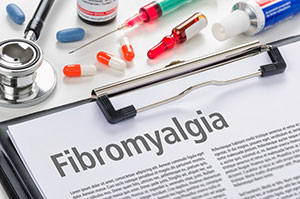
The Alpha-Stim is a clinically proven microcurrent device that is to help fibromyalgia sufferers and has just been the subject of a successful trial on the NHS. A recent study found that microcurrent cranial electrical stimulation significantly reduces pain, fatigue, sleep disturbances and improves functional status in fibromyalgia sufferers. The study from the University of Virginia School of Medicine, investigated the effects of microcurrent cranial electrical stimulation (CES) therapy on lessening pain and its associated symptoms in fibromyalgia (FM) sufferers[1]. The researchers found that “those individuals using the active CES device had a greater decrease in average pain, fatigue, and sleep disturbance than individuals using the sham device or those receiving usual care alone over time.” In addition, the report concluded that “individuals using the active CES device had improved functional status versus the sham device and usual care alone groups over time”. Fybro is typically treated using drugs including antidepressants, opiate analgesics and calcium channel blockers. Although most of these have shown to work to some extent (in up to 50% of patients), the effects on pain are minimal. This means that there is a real need for additional treatment approaches. Based on the evidence that the brain processing of pain is disturbed in fibromyalgia sufferers, it is assumed that treatments that target the brain would be especially effective. Over the years, several types of electrical stimulation of the brain have been used to reduce pain or depression. However, most of these use high-strength current (electroconvulsive therapy) or an electrical field (repetitive transcranial electromagnetic stimulation), and because of this, they are only available in specialised facilities with trained health care professionals. In contrast, microcurrent cranial electrical stimulation (CES) devices such as the Alpha-Stim deliver a safe, specially designed level of microcurrent that is suitable for use at home. The effects of the AS are transmitted through a direct action on the brain, likely at the limbic system, hypothalamus, thalamus, and/or the reticular areas. In humans, electroencephalographic (EEG) studies have shown that CES can influence alpha activity (increase or decrease) and decrease delta and theta activity in the brain. In human participants with pain, CES treatment reportedly altered the EEG patterns to more closely resemble patients that are pain-free. In preliminary clinical studies using the LISS Cranial Stimulator, participants had increases in plasma serotonin and b-endorphin. Another study that lasted 3 weeks, reported significant improvements in FM pain and in quality of life in those using the CES, compared with those using the sham device. [2] Results from a major NHS study into Cranial Electrotherapy Stimulation (CES) provided by the Alpha-Stim and how it helps those with anxiety disorders, were announced at the annual MindTech Symposium last December[3]. The study, which also revealed how CES helps with sleep, aimed to establish the clinical and cost effectiveness of this new form of treatment for those who have already tried basic psychological therapies unsuccessfully. The CES device used in all these studies is the Alpha-Stim. Prices start from £549. For more information please visit www.alpha-stim.co.uk or call 01487 208041.
DFN Charitable Foundation Begins Bold New Chapter
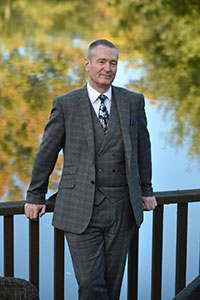
DFN Charitable Foundation Begins Bold New Chapter: Organisation confirms CEO appointment. The DFN Charitable Foundation, founded in 2014 by David Forbes-Nixon, has announced the appointment of a new CEO as it continues its life-changing work for those with learning difficulties and disabilities. Kevin Horne, from Norwich, joins as CEO of the DFN Charitable Foundation (‘the Foundation’) and DFN Project Search after 21 years heading a multi-million pound business services enterprise, through which he actively developed employability initiatives to support those with learning disabilities. He will work with trustees and supporters to ensure the success of projects being carried out by the Foundation, and by its dedicated employment initiative, DFN Project SEARCH.“The DFN Charitable Foundation is delighted to announce the appointment of Kevin Horne, who has today joined as CEO of the DFN Charitable Foundation and DFN Project Search. As CEO, Kevin will work with trustees to deliver real change in the fields of special education, most importantly improving access to employment for young people with learning difficulties, disabilities and autism. We urgently need to nudge government, both national and local, and businesses, into shifting the goalposts in favour of the young people who access DFN Project SEARCH and other internship programmes around the country.” said David Forbes Nixon, Chairman. Nationally, the DFN Charitable Foundation’s aim is to challenge and positively influence current practice in order to enhance the lives and opportunities of young adults with learning difficulties, disabilities and autism. It seeks to ensure full entitlement to effective training, leading to employment and a better quality of life experience. The Foundation provides innovative employability skill strategies that support these young people, promoting greater employer engagement and increasing opportunities for sustained paid employment. Current UK employment statistics for this vulnerable group of young people stand at less than 6%, whilst more than 75% have clearly stated that they want to work. This statistic makes the charity’s recently conceived DFN Project SEARCH, all the more important. It delivers the UK’s largest and most effective programme for getting young people with SEND into paid employment. DFN Project SEARCH local programmes are, on average, delivering employment rates of 66%. The DFN Project SEARCH Programme is a franchise of Project SEARCH US which started at Cincinnati Children’s Hospital Medical Center in 1996. Today Project SEARCH currently has over 600 licensed programmes spanning 47 US states, 9 countries and in multiple industries. DFN Project SEARCH currently operates in about 60 sites across England, Ireland, Portugal, Scotland and Wales in various host businesses employers, which include Hospitals, Local Authorities, Universities, Laboratories and a variety of Private Sector Businesses. “I truly believe that these young people are capable of making a real economic and social contribution to our society if they are given the correct education, training and support which only programmes Project SEARCH currently provide.” said Kevin Horne, CEO. “Employment helps young people value themselves and others, offering them the chance of developing greater independence. It provides opportunities to form lasting relationships and friendships. “Importantly, it offers the hope of becoming economically independent without the need to rely on benefits and the tremendous prize of greater personal and social independence.” Find out more here
Easy Bathrooms launches accessible range of bathroom products
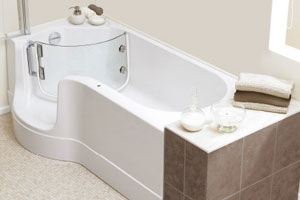
Easy Bathrooms – the bathroom and tile supplier – has launched a range of quality, affordable accessible baths and accessories. £30,000 has been invested into the development of the products, which allow safe, easy access, each designed to fit into a range of spaces – from a small en-suite to a large master bathroom. Six baths have been introduced as part of the firm’s new ‘Easy Living’ range, alongside complementary accessories and parts. The Vestra bath is 945mm x 170mm, including a screen and an electronically-operated glass door, which remains locked until all water has been drained, providing peace of mind for the buyer that leaks will be avoided. The low-threshold height also gives the user easy access. The Truo unit has similar features, but is also available in high gloss black, allowing buyers to match their bath to the rest of their room choices. Munro is the smallest unit in the range, at 650mm x 900mm, with an inward-opening door and a moulded seat, allowing the user to sit down while they bathe. Neil Bell, head of retail at Easy Bathrooms said: “Homes are becoming more and more multigenerational, meaning that they need to cater to family members of all ages and abilities. “These baths are now an additional option, alongside wetrooms, for tradespeople – they are designed specifically to help the end user to live a more comfortable life, while ensuring the fitter maximises the use of space, even in the tiniest of rooms.” The firm also offers thermostatic showers, which reduce the risk of scalding; and textured floor tiles, which minimise the possibility of slipping. Easy Living brochures are available to pick up from all of Easy Bathrooms’ showrooms nationwide. Or call 0330 660 1120 to get one delivered. www.easybathrooms.com
MOWOOT Chronic Constipation Therapy Device
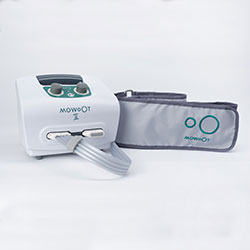
MOWOOT – the Natural Solution to Chronic Constipation MOWOOT is a new abdominal massage therapy system for chronic constipation. MOWOOT treats, manages and prevents chronic constipation without laxatives, enemas and colon cleansing supplements. MOWOOTis designed for home use and for use in clinics, hospitals and care homes. MOWOOT is compact, portable and easy to use. MOWOOT is light to carry and features a handle for easy lifting during moving from room to room and during travel or transportation. MOWOOT overview Safe, effective and clinically proven Helps to achieve regular and easier bowel movements Reduces discomfort and pain associated with constipation Eliminates intestinal gasses Reduces pain associated with abdominal bloating Reduces discomfort caused by evacuation Reduces time spent in the bathroom Improves health and wellbeing Improves appetite Improves quality of life Easy to use, comfortable and pleasant in use Convenient non-invasive and non-irritating treatment Cheaper than long-term ongoing purchases of laxatives Can be used sitting or lying down, thus utilising time Daily sessions of 10 to 20 minutes duration Improvements achieved as early as 3 to 7 days after first treatment Long-term use delivers lasting health benefits Treats 1 or 2 people simultaneously, as required Mains powered Medical device (CE 0086) 2 years warranty MOWOOT mimics manual abdominal massage normally performed by therapists, nurses or carers. Abdominal massage speeds up intestinal transit in people with chronic constipation and relieves constipation. MOWOOTis clinically proven to double evacuation frequency, soften stools, improve regularity, reduce gasses and bloating, relieve abdominal discomfort and effectively combat chronic constipation. MOWOOT can help people commonly suffering with chronic constipation, such as people with spinal cord injuries, multiple sclerosis and Parkinson’s Disease, people with constipation caused by taking certain medications, menopausal and post-menopausal women and the elderly people. Non-invasive and drug-free, MOWOOT abdominal massage therapy does not have side-effects associated with pharmacological anti-constipation interventions. MOWOOT therapy does not lose its effectiveness with long-term use. Comfortable and simple to use day after day, MOWOOT delivers effective solution to problems of chronic constipation. Regular daily use of MOWOOT alleviates constipation and improves quality of life! Just 10 – 20 minutes per day of MOWOOT abdominal massage produces improvements and significant results in only 3 – 7 days after the first treatment. Positive health benefits and greater quality of life are achieved with long-term daily use. MOWOOT abdominal massageis pleasant and relaxing. You can use MOWOOT sitting or lying down, when relaxing, reading, watching TV or working on your computer. MOWOOT is a desk top device with massage delivered via 4 independently attachable massage treatment belts. During treatment, a massage treatment belt is wrapped round the waist of the treated person. MOWOOT can treat 1 person or 2 people simultaneously as the MOWOOT desk top unit can connect with 1 or 2 treatment belts. This makes MOWOOT very convenient for use in family settings with more than one chronic constipation sufferer and in care homes, where many people may need constipation relief treatment. MOWOOT massage treatment belts are made in 4 sizes and you simply choose the belt in your size. One MOWOOT device can treat more than one person, provided a belt in appropriate size is available. MOWOOT is a Class 2 Medical Device (CE 0086). For more info on MOWOOT contact Win Health Medical Ltd by phone on 01835 864866 or via e-mail to info@win-health.com or visit www.win-health.com Win Health Medical Ltd Unit 1, Oxnam Road Industrial Estate Jedburgh, TD8 6LS T: 01835 864866 / F: 01835 268136 E: info@win-health.com/ W: www.win-health.com M: https://www.win-health.com/mowoot2-chronic-constipation-therapy-system
Study by the FSA exposes young people with food allergies fear eating out

A new study conducted by the Food Standards Agency ( FSA ) has exposed that a high percentage of young people aged between 16-24 with food allergies fear eating out at restaurants and in some cases, have specifically avoided going out to eat. The FSA study showed a staggering 64% of food allergy sufferers had avoided going out in the last 6 months. These results could be down to the lack of faith allergen sufferers have in restaurants and menu options, or it could be that they’re comfortable with a certain restaurant and do not wish to ‘create a scene’ at a new establishment. The food industry has worked to give greater transparency on nutritional and allergen information across the last 5 years, after the European Commission introduced the ‘Food Information To Consumers’ legislation in 2014. This legislation made it compulsory to detail nutritional and allergen information on food packaging and non-prepacked food, including in restaurants and cafes. Responses to the FSA survey detailed that a high percentage of allergen sufferers were aware that it was a legal right for businesses to openly show ingredient information on the top 14 allergens. Understandably, when it’s a literal matter of life and death, sufferers may be cautious when trying new restaurants and dishes. Customers want to feel confident when ordering food and have an enjoyable and relaxing time when out. ELAS Food Safety Director, Fiona Sinclair, illustrates the hard work that the majority of food businesses have undergone to help allergy sufferers: “On one hand it is the case that the food industry overall provides more allergen information and has better controls in place than ever before. With the introduction of the Food Information for Consumers Regulations in 2014, many businesses have now got robust procedures in place to comply with the law and keep customers with allergies safe. For example, accurate information on allergens for each menu item, signage encouraging customers to tell them about their allergies, allergen buttons on tills, allergen awareness training for staff and managers and tight communication if a customer has an allergy. On the other hand, from our experience too many businesses still don’t have safeguards in place, some virtually none, and in such cases consumers are right to exercise cautions. We find this to be more common with smaller businesses who may still be unaware of requirements. For consumers with serious allergies their life is virtually in the hands of a chef or waiter. There are a few suggestions we would suggest for consumers with allergies, to help them assess whether the place they wish to eat out can be trusted. For example, check their food hygiene rating although this is a quite basic measure and not the be all and end all. Asking for allergen information, if it is not provided up front is a must, and gauging how the staff respond. Don’t be afraid to ask them what precautions they will take with your meal. Your’re much more likely to get a clear and forthcoming answer from a premises with safe and clear allergen procedures, well trained staff and effective management in place. Here at ELAS, some of our restaurant group clients have excellent procedures in place and as a result gain a lot of repeat business, as allergy sufferers trust them. However they still want customers to tell them at each visit if they have an allergy so they can take extra care when prepping their meal. So in summary, we can understand caution in eating out, but would recommend asking a few simple questions to gauge whether your restaurant or takeaway of choice can be trusted.” In May we held and STS Food Safety Round Table which resulted in a whitepaper focusing on allergen control within the food industry. Our whitepaper details the steps that businesses can take to safeguard their customers and employees when dealing with allergens. Some of the points discussed include: – Making sure your training is up to scratch – Your supply base management – Avoiding customer complacency – Reporting allergen complaints – Technology solutions You can download our Allergen whitepaper here.
The MOT Rules for WAVs Have Changed
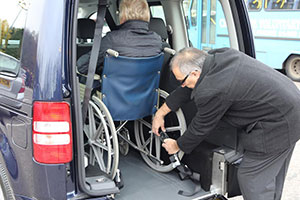
If you own a Wheelchair Accessible Vehicle which is approaching or more than 3 years old, there have been some important changes regarding the requirements of the MOT Test, which now state under Section 7.1 (Seat belts and supplementary restraint systems (SRS)) that the MOT Tester must inspect: What Has Changed? Under previous MOT regulations there was no requirement for either the Wheelchair Occupant Safety Belt or Wheelchair Restraint Belts to be inspected. These new changes mean that your vehicle’s MOT Test can provide greater peace of mind that your WAV’s wheelchair restraints are in good working order. Brotherwood® have been campaigning for years for more stringent safety checks for critical wheelchair and passenger restraint systems, which are crucial for the safe transportation of wheelchairs and their users, and so we welcome these new regulations which ensure that your vehicle can continue to safely serve your needs for years to come. Why Is It Important? The WTORS (Wheelchair Tie-Downs and Occupant Restraint System) in your vehicle not only provide safety for the wheelchair user, but also all other vehicle occupants when travelling. These systems also provide a secure, stable ride for the wheelchair user and so inspecting these systems for proper operation and ensuring that they are free from damage will mean that your WAV continues to provide a comfortable, enjoyable journey. Can Brotherwood Inspect My WAV? For complete peace of mind we offer an annual Safety Assurance Programme. A qualified service engineer will visit at a time and place that suits you, to perform a full 15-point conversion safety inspection, including restraints, ramp, safety belts and more to ensure safe operation of your conversion. Although this is not an MOT Test, it can make sure that your wheelchair access conversion is operating at it’s best. To arrange a Home Service Visit, please Brotherwood here.
5 Most Common Misconceptions About Life with a Disability
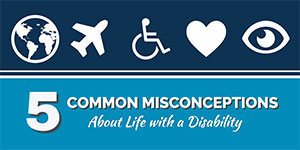
It’s an unfortunate fact of life that many people living with a disability have to deal with misconceptions and stigma on a daily basis. From ignorance and prejudice, to barriers to work and education, the effects of these misconceptions can have profound and wide-ranging effects on the lives of disabled people. UKS Mobility recently talked to 18 bloggers about their experiences and the misconceptions that those living with a disability face. Here, we take a closer look at the most common misconceptions they mentioned. We hope this will help raise awareness and reduce the stigma and improve conversation around disability. 1. All people with disabilities use wheelchairs This is one of the biggest misconceptions surrounding disability. People are often only assumed to be disabled if they use a wheelchair, but this erases a large proportion of the disabled community. Just 8% of people with disabilities use a wheelchair. In fact, disability covers a very broad spectrum of conditions. Many disabilities are invisible, such as visual and auditory impairments, autism, fibromyalgia and mental health conditions such as anxiety and depression. Each of these disabilities can have a profound effect on the person affected, but often these people are left underserved by society or even treated as frauds. By reducing disability to a very narrow spectrum, we leave people facing more stigma. Kirsten Schultz, who blogs at Not Standing Still’s Disease explains the way this misconception makes life more difficult: “Having multiple invisible illnesses, I struggle with people not believing I’m sick. I get sneered at from older people, stared at by those closer to my age and occasionally get comments about using my handicapped placard.” Similarly, Katherine Bouton notes the extent to which people assume that having a disability = using a wheelchair: “Quite a few people I know have checked off “hearing loss” as a disability needing accommodation at an airport (meaning signs, etc) and have found that someone has instead sent a wheelchair to meet them at the gate.” 2. People with disabilities don’t want or can’t be in relationships The idea that disabled people are unable to have romantic and sexual relationships is one of the most damaging misconceptions, as it creates a barrier that makes it more challenging for people with disabilities to experience these things. A lot of people assume that those with disabilities are asexual or don’t have the same need for love and romance. This frequently crosses the line into prejudice and preconception – in 2008, 70% of UK adults surveyed said that they probably wouldn’t have sex with someone with a physical disability. This misconception often means people with disabilities are not given adequate levels of reproductive and sexual health education whilst at school. This can cause problems further down the line, leaving younger people and those with learning disabilities particularly vulnerable to abuse. It’s vital that people with disabilities are given access to the same education and services as able-bodied people. Similarly, it’s often assumed that people with disabilities can only date other disabled people. Nicola Golding describes her experiences with this: “People always seem surprised when they find out my boyfriend is my boyfriend because they always assume he’s my brother. If someone hasn’t met then the first question I’m often asked about him is ‘is he disabled too?’ which always feels like people assume I couldn’t have an able-bodied partner.” 3. People with disabilities don’t want to travel Many people believe that those living with disabilities can’t travel, or don’t want to travel. This is often based on a narrow set of assumptions – for instance, that those with disabilities don’t have the money to travel, or even that they’d “obviously” rather stay at home. In reality, this simply isn’t the case. Many people with disabilities love to travel; in just two years in the USA, 25 million adults with disabilities made trips for leisure and business, altogether taking 73 million trips and spending around $17.3 billion. Despite this, it’s often a lack of accessible facilities that poses the biggest challenge to disabled travellers. Businesses and hotels often don’t know what people with disabilities need and fail to provide adequate facilities. For example, nearly three quarters of airline passengers with disabilities have experienced physical obstacles or miscommunication with airlines, and 8 in 10 have reported barriers and difficulties in UK hotels and resorts. It’s clear that the most important step to resolving issues around travelling with a disability is more understanding and better accommodation of disabled peoples’ needs. As blogger Cory Lee puts it, “We lead extraordinary lives and want to travel, just like anyone else. We just need destinations to be a bit more accommodating to make that a reality. When destinations do focus on accessibility, we’ll be thrilled to visit and spend our money there.” 4. People with disabilities are dependent on others It’s often assumed that people with disabilities can’t be independent and require large amounts of assistance and care. This is rarely the case. People with disabilities may have to adapt the way they do things, but this doesn’t mean that they can’t live independent lives. This can lead to patronizing behavior and awkward situations – for example, people with disabilities often find that people don’t talk to them directly, instead directing conversation at their friends and companions. “People in public try to talk to whomever I’m with, but I often open my mouth and surprise the stranger,” explains Laura Robb. We need to remember that people with disabilities are individuals and should be treated as such. Moreover, they can lead fulfilling and independent lives. Glen from Well Eye Never articulates this misconception: “It then takes people by surprise when they learn how much I do actually get out and about, on my own or with others, visiting lots of different places and having fun at lots of social events.” 5. Life with a disability isn’t normal Really, many of the other misconceptions about disability stem from this one – that life with a